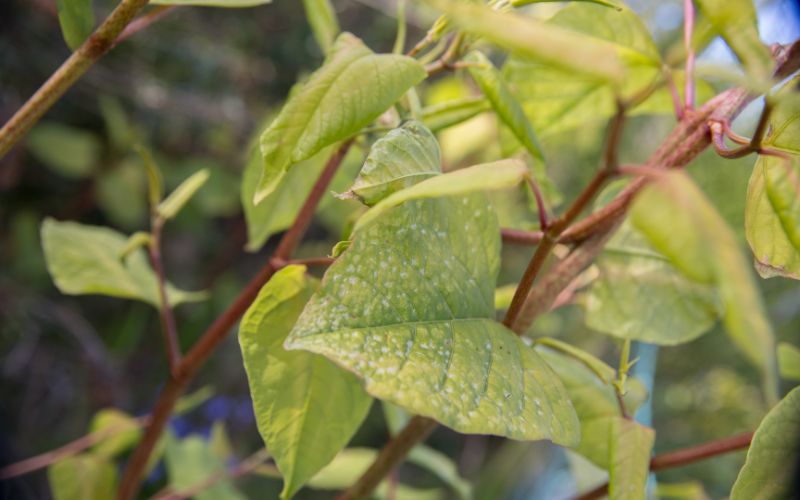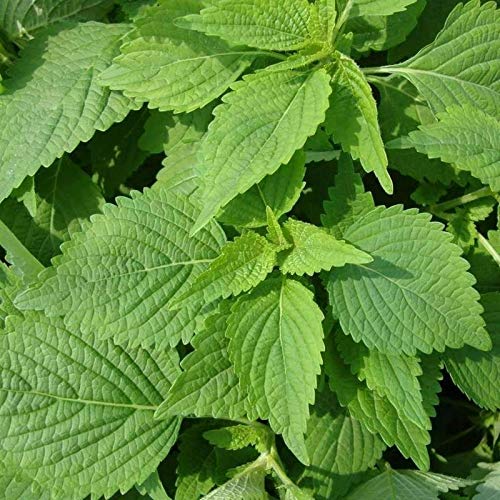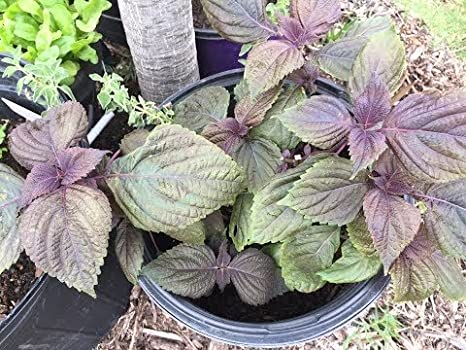Japanese Shisho, also known as Perilla frutescens, is a popular herb in Asian cuisine.
The plant is part of the mint family and has a distinctively sweet flavor with hints of anise.
It’s often used as a garnish or seasoning in dishes like sushi, sashimi, and tempura.
Shisho thrives in full sun to partial shade, in a soil that is rich and well-drained. Allow transplants to establish themselves before growing as you would basil — pinch the developing tips every so often to create bushier plants with more leaves. Water frequently, especially during the hot season.

Getting Started
To get started, you’ll need some shisho seeds.
You can purchase them online or at a local nursery.
Once you have your seeds, you’ll need to start them indoors about eight weeks before the last frost date in your area.
[amazon box=”B07JHZ21TL” template=”horizontal”]
Sowing Shisho seeds
Fill a planting tray or pot with a quality seed-starting mix and moisten it thoroughly.
Sow the seeds on the surface of the soil and lightly press them down.
Cover the tray or pot with plastic wrap or a lid to create a mini greenhouse effect.
Place the tray or pot in a warm, sunny spot and keep an eye on the soil. It should stay moist but not wet.
Once the seeds have germinated (in 7-14 days), you can remove the cover.
Continue to grow your shisho seedlings indoors until all danger of frost has passed.
At this point, you can transplant them into your garden or into larger pots.
Caring for Your Shisho Plant
Japanese shisho plants are fairly easy to care for and are quite tolerant of a range of growing conditions.
They prefer full sun but will also do well in partial shade. Well-drained, fertile soil is ideal, but shisho will also grow in average garden soil as long as it’s not too wet.
Water your shisho plants regularly, especially during dry spells. Apply a balanced fertilizer once a month during the growing season.
You can also add some compost to the soil around the plants to help them stay healthy and productive.

Can you grow Shisho in pots?
Yes, shisho can be grown in pots. Choose a pot that is at least 12 inches wide and has drainage holes.
Fill the pot with a quality potting mix and water it well. Place the pot in a sunny spot and water regularly, as needed.
Fertilize monthly during the growing season. You may need to repot your shisho plant every year or two to keep it healthy.
Pests and Problems
Japanese shisho plants are relatively pest- and disease-free. The biggest problem you’re likely to encounter is root rot, which can occur if the soil is too wet or poorly drained.
If you see yellowing leaves or stunted growth, check the roots. If they are soggy or soft, you’ll need to take action to improve the drainage and reduce the amount of water you’re giving the plant.
Aphids, whiteflies, and spider mites can sometimes be a problem. These pests can be controlled with insecticidal soap or neem oil.
Harvesting Shisho
You can start harvesting shisho leaves when the plants are about 6 inches tall.
Pinch off the tips of the plants to encourage bushier growth.
You can also harvest the whole plant by cutting it back to about 4 inches above ground level.
This will stimulate new growth and give you a second crop of leaves later in the season.
How long does Shisho take to grow?
From seed to harvest, shisho takes about 90 days to mature.
You can extend the harvest by starting seeds indoors and transplanting them into the garden after the last frost date.
You can also sow seeds directly in the garden, but you’ll need to start them about two months before the last frost date.
When is Shisho in season?
In most regions, shisho is in season from late spring through early fall.
However, if you live in a warm climate, you may be able to grow it year-round.
Is Shisho an annual or perennial plant?
Shisho is an annual plant, meaning it will only live for one growing season.
However, if you live in a warm climate, you can often get two or even three crops from a single plant.
What does Shisho taste like?
Shisho has a mild, slightly peppery flavor that is similar to other members of the mint family.
It’s often used as a garnish or added to salads and stir-fries.
How do you store Shisho?
Fresh shisho leaves can be stored in the fridge for up to a week.
You can also dry or freeze them for longer-term storage.
To dry shisho, tie the stems together and hang them upside down in a dark, dry place.
Once the leaves are completely dry, crumble them and store them in an airtight container.
To freeze shisho, wash and dry the leaves and then place them in a freezer bag. Squeeze out as much air as possible before sealing the bag.
Frozen shisho leaves will keep for up to six months.
At a glance growing a Japanese Shisho plant
Japanese shisho plants are relatively easy to grow and make a nice addition to the garden.
Here’s a step-by-step guide to growing shisho from seed.
- Start your seeds indoors about eight weeks before the last frost date in your area.
Fill a planting tray or pot with a quality seed-starting mix and moisten it thoroughly.
Sow the seeds on the surface of the soil and lightly press them down.
- Cover the tray or pot with plastic wrap or a lid to create a mini greenhouse effect.
Place the tray or pot in a warm, sunny spot and keep an eye on the soil. It should stay moist but not wet. Once the seeds have germinated (in 7-14 days), you can remove the cover.
- Continue to grow your shisho seedlings indoors until all danger of frost has passed.
At this point, you can transplant them into your garden or into larger pots.
Final Words
Japanese shisho is a versatile herb that can be used in many different dishes.
It’s easy to grow from seed and can often produce two or even three crops in a single growing season.
Whether you’re looking for a new garnish for your salads or stir-fries, or just want to add some flavor to your dishes, shisho is definitely worth a try.




